Using Glassdoor for Competitive Insights
Glassdoor Company Reviews Can Yield a Number of Valuable Insights When Performing Competitive Research
Performing competitive research is more an art than a science at times and I’ve found that a lot of Product Marketers aren’t all that good at performing meaningful competitive research. As a result, what Product Marketing organizations create often varies from one company to another. And the competitive “insights” don’t always amount to real insights. So, I thought I’d share one tool I’ve used for gleaning insights.
A couple caveats first though. While there are certainly tools out there that can be used to pull in information on companies, topics and the like – I’m thinking tools/services like Klue, I believe it’s critical for Product Marketers to get their hands callused and dirty to conduct more manual competitive research. Why? This is because automated tools can only do so much to pull in information, analyze it, put it into a broader context and infer key learnings from it. I think this is a brain muscle Product Marketers should have and then go off and engage tools that help scale competitive research at your organizations. This way, you really understand how to really leverage these great tools to get real value from them.
I look at competitive research at a few different levels and want to make the distinction here as this may be how you want to consider competitive research for your organization.
Corporate-Level Competitive Research – This is competitive research conducted at a company-level. For instance, I may want to know about my top three competitors, how they position their companies, what they call out prominently, what marketplace moves they’ve made recently, what their level of innovation might be and what they are working on, confidence in leadership and company direction, etc.
Category-Level Competitive Research – This is research that hones in on a market segment that is pertinent to your company and seeks to better understand the competitive landscape such as what defines the category, who are the major and minor players, how well your company fits within the category, etc. For instance, if your company is involved in cloud optimization services, you may very well be interested in knowing how cloud migration and cloud strategy consulting segments relate to the prospects for your company.
Portfolio-Level Competitive Research – This is closely tied to comparing broader portfolios of offerings your competitors have against what your organization offers. This may be blended into corporate-level and offering-level competitive information.
Offering-specific Competitive Research – This is research that creates a head-to-head between your offering and competitive offerings to help you understand how your product/service/solution/platform is different from competitive offerings and how best to positive against those offerings.
Now that we have that out of the way, it’s important to call out that conducting competitive research means that you go to a competitors website, read everything about it and build a competitive battle card. You need to conduct more research and look for small gems across a number of resources. Of course, this approach inevitably has diminishing returns as you can spend a lot of time looking at sites that don’t yield much more information than what you gleaned already from just a few resources.
For perspective, when I conduct competitive research, I might pull in information from a number of the following sites (in no particular order). This isn’t exhaustive and the places you look for competitive insights will vary based on your industry, business, business model, etc.
- The competitor’s website
- Glassdoor (the focus of this post)
- Analyst reports (ex. Gartner, IDC, Forrester, ESG, 451 Group, etc.)
- Analyst review sites (for instance, Gartner Peer Reviews)
- Customer review sites
- Third-party industry websites
- Public filings such as 10-Q reports
- Various Google searches
- Current employees who worked at a competitor company
- Newer customers who previously used a competitor’s offering
Now that we got that all out of the way, let’s talk about Glassdoor.
I like Glassdoor company reviews despite that I believe they are gamed quite extensively by organizations to give higher ratings than many companies deserve. However, I have a way I get around that which I’ll share.
The type of competitive information I see gleaning from Glassdoor is more at the corporate and portfolio levels. If you’re looking for offering-specific competitive research, Glassdoor isn’t good for that. Also, don’t use Glassdoor as your only resource. Takes pains to try and affirm insights elsewhere.
So, here’s where I usually draw insights:
- Confidence in leadership, a snapshot and over time
- Confidence in company direction, a snapshot and over time
- Overall employee sentiment
- Indications of company performance issues, major challenges, layoffs, etc.
- Threads to pull on through other research
Here’s how I approach it – I’ll number these to make this more step-by-step. Note: I am going to pull in screen shots of Glassdoor here but obfuscate the company I am researching for this exercise).
Step One – Search for the target company on Glassdoor.com
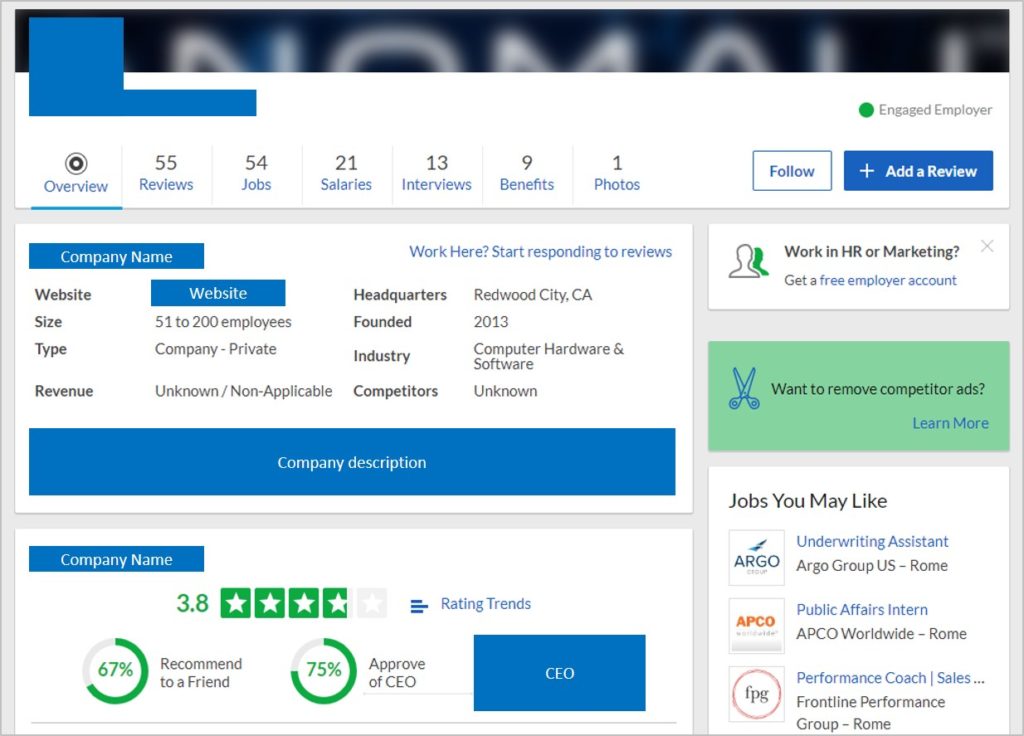
Right here, I can see that this company posts a very respectable 3.8 rating across employees, former employees and others. That’s actually a pretty decent rating. For me, anything below 3.3 starts to get weak. I also see that they have a 75% CEO approval rating which again, is a respectable number. So, on the surface, I see some good things here about this company.
Step Two – Review Ratings and Trends
Next, I click on the “Rating Trends” link right next to the company’s overall rating of 3.8 to get the view below.
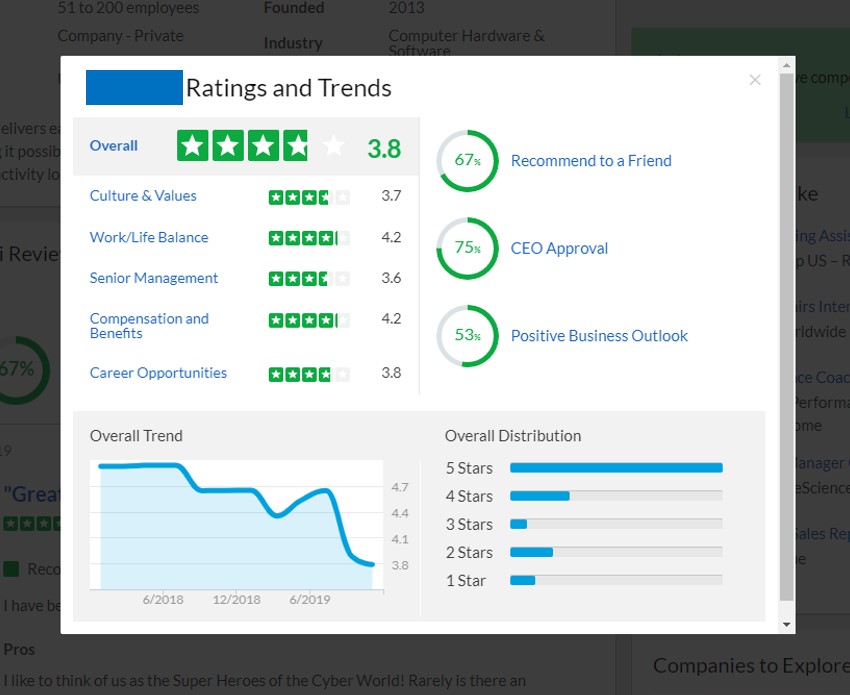
Now, you can see on the Ratings and Trends that I have what looks to be an odd curve as an overall trend in the last 12 months. We’ll note that as something to understand more about. On the right, I’m more interested in the “Positive Business Outlook” (BTW, I recently saw where this is described a little differently but then see it seemingly changed back) but ultimately means number as something to note as well. I don’t generally use the “Recommend to a Friend” statistic but you can.
Notice the “Overall Distribution” on the lower right. That’s a lot of 5 star reviews. I have a bias here which I’ll share with you. I don’t believe any company is worthy of 5 stars. 4.5? Possibly. But 5 stars? I don’t think so. Every company has its quirks, challenges, issues, positives, etc. None of them are wholly perfect. To me, a company that posts 4.0 is likely a damn fine company overall (if that 4.0 is reliable which we’ll get to). I actually wish we’d see Glassdoor, Uber and other companies that rely on reviews to go to a ten-point scale versus a five-point scale for this reason. My recommendation to you is to think along the same lines as you go forward, and my takeaway from the above is that I suspect some “gaming” of reviews has happened along the timeline above which could help to explain some of the odd trending.
Step Three – Analyze Actual Reviews
Now, let’s dig in to the actual analysis and get to what we believe is the truth here. You might be thinking, “Well, isn’t that very subjective to come out with a final rating you believe is correct as opposed to what employees rated?” Yes, that is true. However, given the frequency I’ve seen what I believe are gamed reviews, I believe this process actually gets you closer to truth than taking the initial stats showing up in Glassdoor.
PICK YOUR TIME FRAME. If you haven’t done an analysis on the competitor in the recent past, then I suggest sticking to the last 12 months in your analysis. If you find a lot of reviews for a given company – too many to review – you can reduce that range down to 6 or 9 months. If you have conducted a competitive review fairly recently, you might just look at the time span since then. For purposes of this exercise, I am going to go back 12 months – especially since we have a strange overall trend line and lots of 5 star ratings.
REVIEW EACH REVIEW. When going through each review, I’m on the hunt to answer a few things from each review:
- Who is this review written by in terms of the company’s organization – a particular department or operation? For instance, in the cybersecurity realm, I might want to know whether a reviewer is/was part of the company’s security operations or customer support or another key team.
- If the review is a ‘5,’ do I feel like the review was written by leadership or by an employee directed by leadership to post a strong review of the company?
- If the review is a ‘1,’ do I feel like the reviewer is overly disgruntled and out to overly damage the company’s reputation?
- What positive aspects seem noteworthy?
- What negative aspects seem noteworthy?
You’re going to keep a ‘scorecard’ and notes as you go. Here’s how I might do it.

One note about 5 star reviews. If you think logically about leaders and others trying to push up Glassdoor reviews, giving a company a 5 star is the only real value to give. Just marking the company a ‘4’ will not have much of an impact at all across a large number of reviews. It takes a handful of ‘5’s to have that impact. So, it’s very unlikely that a 4 star review is gamed, in my opinion.
So, on my very first review (seemed to be a prioritized review), here’s what I found which is a good example of what I believe is a review gamed by leadership. I’ve called out the highlights of why I believe this is the case. And because I feel this is gamed, I’ll mark it as such on my tracking sheet for now.

On my second review which was done about two weeks after the first, we get a very different picture of the organization.
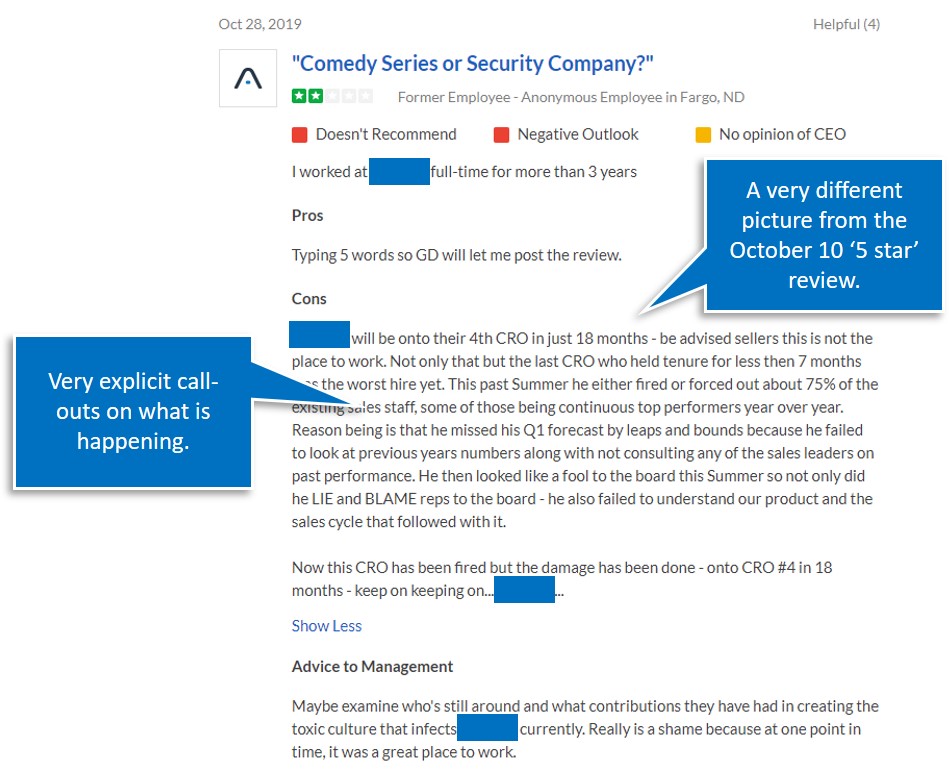
Now, with the review above, this is where I might take some notes. The reviewer was very explicity on CRO and Sales turnover here. So, this is actually good insights on the company and company performance. However, I would like to see more corroboration in other reviews. And by the way, even though this is a very negative review, because the reviewer gave it a ‘2,’ and they don’t seem utterly out to destroy the company, I don’t reject it.
Here’s an example of a 1 star review. In this case, I felt this is a legitimate review to include.
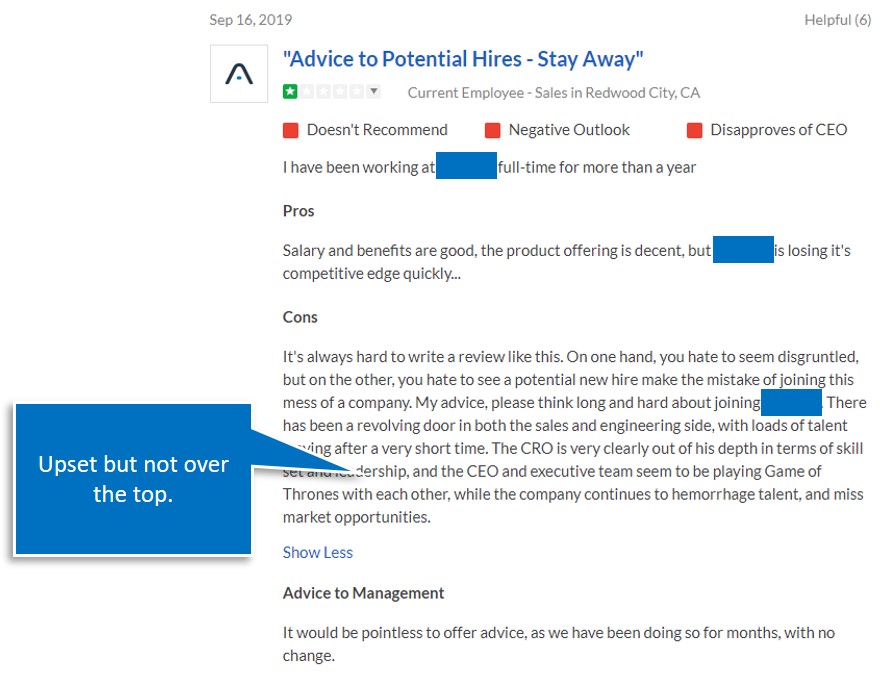
Now, here’s another example of what I believe is a gamed 5-star review. As I go through each review, especially when I see numerous less glowing reviews, this stands out all the more.

Sometimes you have to read between the lines. For instance, after reading this 5 star review, I had to ask myself, “Why did they feel compelled to go to Glassdoor and write something?” Could it be a lower level employee or intern that was told to go write a positive review?
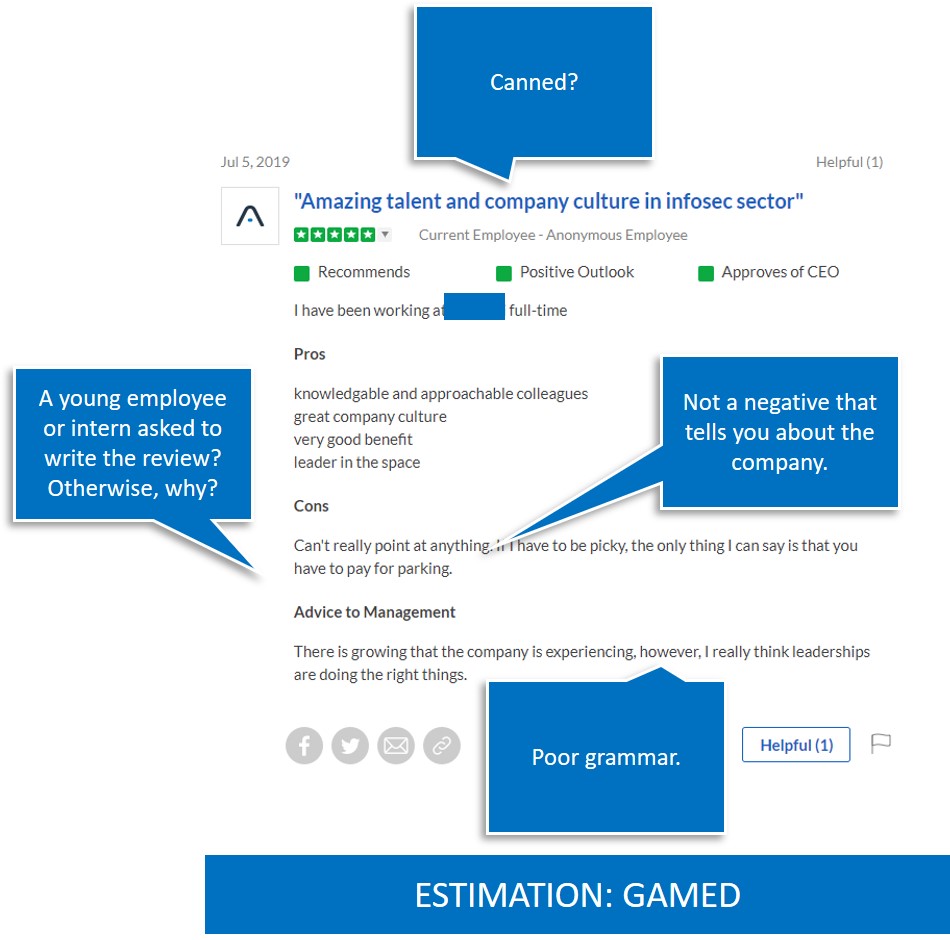
By the way, when you’ve read enough reviews, you start to see patterns and similarities in how bogus 5 star reviews get written. I watch for mentions of ‘free lunches’ and other trivial call-outs that sound more like what I would read on a corporate web page. Or, you might see a list of corporate benefits like only what a HR person could rattle off the top of their head. You might see clusters of 5 star reviews within a short period. You’d be surprised at how there is a similar behavior across gamed reviews across companies. I also watch for 5 star reviews where very little is said and what is said doesn’t indicate anything wrong at all. I think you get the idea now.
Also, I’ve also captured notes on items that stood out to me across reviews. It’s not enough to note something that was mentioned in a single review. You’re looking for common elements across the reviews.
As I review reviews for the last 12 months for this company, I updated my sheet. I marked reviews (5s or 1s) that I felt gamed the numbers. By the way, it also cites issues with CRO leadership and Sales turnover. However, by this time, I’ve seen similar complaints in other reviews I’ve gone through.

So, let’s fast forward now. I’ve gone through all the reviews in the period I allotted. And what I found was a lot of turmoil and gamed reviews at the company. Unfortunately, I saw less comments or perspectives on the products, technology, etc. than what I would normally see. Here is a picture of my notes page now.
Step Four – Tabulate Results

You’ll notice some question marks near a few reviews. Though I was unsure as to whether to include those or not – as gamed or overly disgruntled – I did end up calculating them below. The items marked “G” are where I felt these were clearly gamed reviews and didn’t include them.
In the notes, you can see some learnings out of the analysis. Normally, I do see more in the way of insights and perspectives. In this case, it’s clear that high turnover of CRO leadership and Sales teams is dominating the picture. Comments about the technology, even across bad reviews, suggested that reviewers – and mostly sellers – felt the technology was largely good.
Overall, the takeaway here is that high turnover will likely have an impact on sales outlooks for the foreseeable future. If I am trying to position my sellers against that, I might have them message on the fact that they are going to be the ones dealing with a prospect through the entire process. I may also want to talk to my marketing colleagues about running some type of competitive campaign against the competitor to try to pull in customers who may be feeling like their relationship with the competitor is questionable, or prospects who may be talking with the competitor but seeing turnover in their sales relationship already.
Here’s my tabulation of what’s more real at this company:
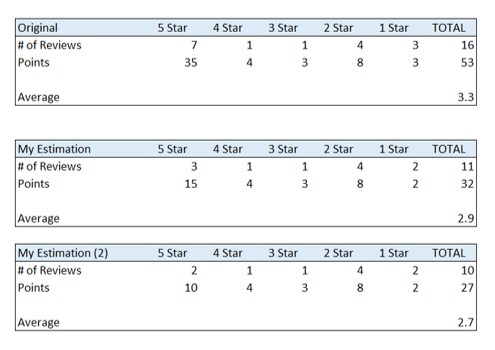
I give the competitor a score of 2.9 to 2.7 versus the 3.3 shown above. Based on the above, I would say that internally, this company has some serious issues in terms of confidence in leadership, turnover in Sales and near-term/middle-term sales outlooks.
If you recall the trending chart from earlier, here’s what I believe:

My guess is that overall, this company has been submitting questionable reviews for an extended period – see the 4.7+ trending in its past. If I went back in time and performed the same analysis, I bet I could get to a much more normal and realistic – and likely poor – curve. However, I don’t care about going that far back as it’s not within my 12 month period.
Step Five (Optional) – New Trending
Because your competitors don’t change from month to month, you may find that you want to update your analysis 6 or even more months later. In this case, do the same analysis but for the new period. You can then compare your prior results with this one. For instance, when recently looking at a competitor who’s been on our radar for some time, we could see a significant upward tick in confidence in leadership, confidence in company direction, more positive sentiment on offerings, and overall employee sentiment within the company. That points to a company that is getting its act together and may pose more of a competitive challenge in the future.
Conclusion
So, I’ve shown you a method to help you glean competitive insights more at a corporate-level from Glassdoor. In my opinion, this is a great example that smart competitive analysis goes beyond the topical statements to get at the underlying real truth. Think of it like this – if you read a competitor’s press releases and took them as word, you would believe that that competitor was the best thing since sliced bread.
The reality is more complex and requires analysis by the Product Marketer. And regardless of the more advanced tools out there that can accelerate your ability to pull in information and present it in a digestible way which is something I’m excited about, it’s the analysis in the middle that distinguishes the value and impact of your competitive efforts.
As a Product Marketer, David has successfully launched products, services, solutions and platforms across a number of disciplines in the technology industry. David’s passion for Product Marketing and his eye for seeing how Product Marketing can lead to even stronger business outcomes led him to bring his expertise and knowledge to Shoot the Curl Marketing.



